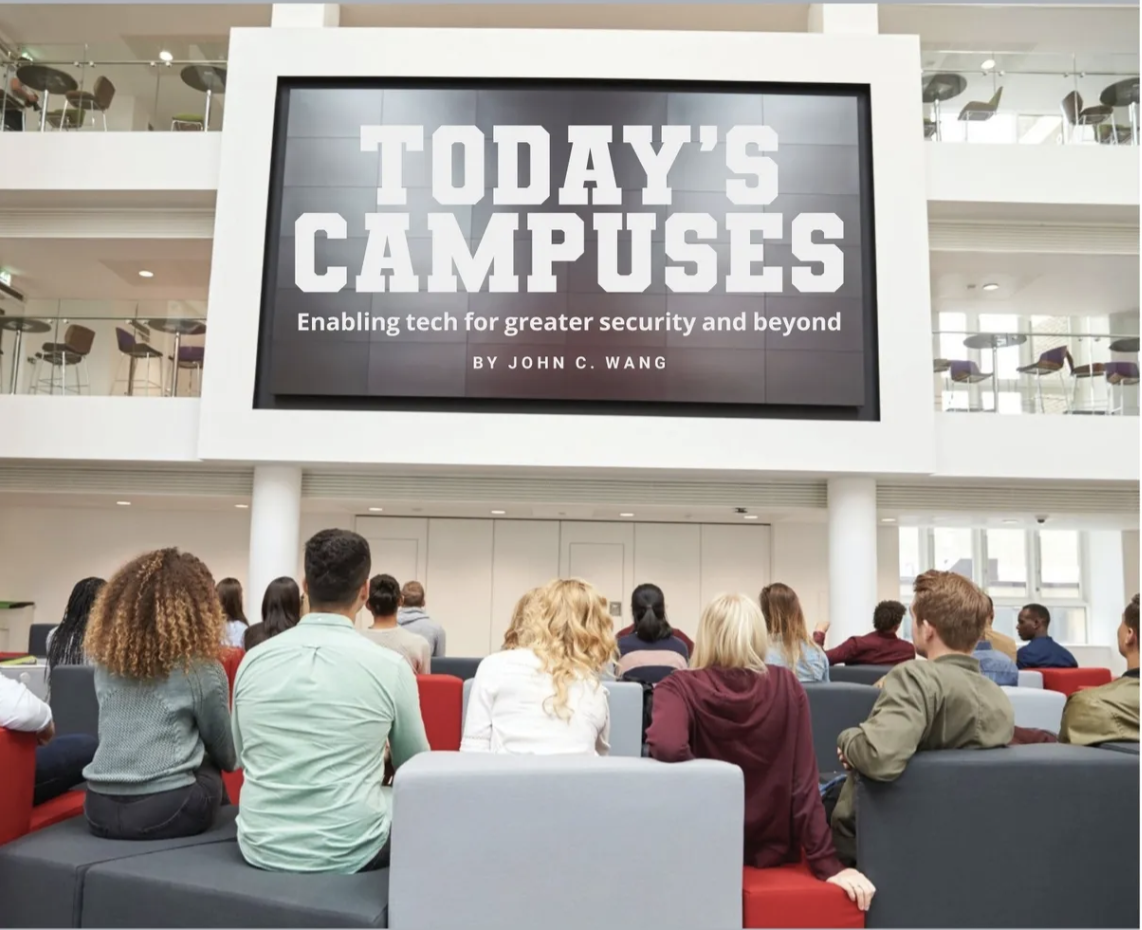This article originally appeared in the May/June 2023 issue of FMJ
Just like workplaces, campuses are in the ongoing process of digital transformation. It is an exciting time not just for students, but for campus facility managers too. Though educational institutions may traditionally be slow on the uptake of technology and new systems, that momentum is accelerating.
 Higher education leaders are acutely aware of students’ ever-rising expectations: they want a campus that embraces new systems and technologies to facilitate seamless movement throughout campuses, or access to the resources on a needs basis — all while being more collaborative and safer.
Higher education leaders are acutely aware of students’ ever-rising expectations: they want a campus that embraces new systems and technologies to facilitate seamless movement throughout campuses, or access to the resources on a needs basis — all while being more collaborative and safer.
Campus FMs are focusing on digital transformation to reshape teaching, learning, and the campus. With the success that many future-facing private organizations have achieved post-pandemic, can this success be replicated within the educational environment?
A good degree of executing plans for digital transformation falls to campus FMs. With new technologies such as smart IoT, analytics, automation — and of course a mobile-first approach for the most tech-enabled generation yet — it is an exciting time for this realm of FM.
Trends in education and what it means for campus FMs
Education is becoming increasingly accessible to a greater range of learners. According to The Times Higher Education, there are now six distinguished types of learners:
- the classic school-learner,
- those who want to enter regulated professions,
- those with a passion for the arts,
- postgraduates developing specialized expertise,
- working professionals who are upskilling, and
- returning students who are looking to conquer the second time round.
This implies the need for a more agile digital transformation to embrace the challenge of designing and delivering new forms of higher education in an appropriately tech-enabled environment, built around the learning needs students with varying goals and objectives.
The campus must also be a safer and securer place to learn. As this need for enhanced campus security grows, it marks a large undertaking necessary in terms of managing who is allowed on the premises in increasingly complex learning settings often spread out across multiple locations. Typically sprawling across multiple buildings and premises, it makes adopting a suitable and all-encompassing access control system challenging. Campus cards initially served as ID cards, verified by eye, to grant access to campuses and other services such as borrowing library materials, but this can be tricky as campuses grow.
It has now expanded well beyond that; access cards are not only for identification, but also function as a universal “key” for access into all areas connected to a school, be it classrooms, the gym or the lab. It then goes further to embrace on-campus purchases, access to specialized learning areas, or tools such as printers. It necessitates a huge investment, and particularly for campuses still using legacy systems.
Lastly, student expectations have increased more than ever before, with their notions of education thoroughly uprooted because of the global pandemic. A recent study by KPMG highlighted this with some insights into students’ changed mindsets. Though online learning became widespread, 71 percent of respondents called campus life “important” to them and valued the in-person experience when learning.
Furthermore, there is near unanimous agreement for the need for integrated digital systems. 80 percent wanted an educational experience that matched their digital lifestyle, while 88 percent want the post-secondary institution experience to be digitally accessible online or via mobile phone.
Reducing the reliance on student cards
Be it going to university or starting a new job, new starters still typically find themselves handed an access card. Seemingly a cheap and cost-effective way of managing access control on or off the campus, when considering other factors, it quickly becomes much of a less appealing option. As of 2016, 19 percent of the student body loses a card every year, or 3.8 million cards. That is an awful lot of missing cards, and with a price tag of around US$5 to $50 each, the average cost of replacing a card is around US$22. That adds up to more than US$80 million a year. Add on top of that the infrastructure necessary for programming cards, card printing hardware and the risk lost or stolen cards can cause, the case for bringing in technology to digitalize the process becomes clear.
Digital wallets — including those of both Apple and Android phones — are helping enable that digital transition and are widely adopted on campuses. They allow students to store their student ID cards quickly and conveniently on their mobile phones and devices. Then, they need to simply tap their phone against an NFC-enabled reader, to gain access to the campus.
Fully adopting digitalized student ID cards is just half the story; there must be relevant card readers placed at key locations to allow access into controlled areas. These can typically present themselves with a higher up-front cost, however it also offers an opportunity for extracting additional value. Besides having integrated NFC readers to ensure they are ‘campus ready,’ readers with integrated screens offer the opportunity for unlocking more value. While the initial upfront cost may be higher, compared to the endless cycle of replacing lost cards and those that have simply degraded and failed over time, the overall cost savings becomes evident.
When used in tandem with integrated security features of smart phones such as face or touch ID, or even a simple four-digit PIN to access the digital wallet, they quickly reveal themselves as a highly effective way of maintaining enhanced security on campus. This also does away with much of the risk of lost and stolen cards, as well as the transference of cards between bad actors who wish to enter the campus for nefarious reasons.
However, card readers can also present security risks, as data is often an afterthought with these devices, allowing easy access to campus systems. For campus FMs, to maintain a securer learning environment – both on and offline – card readers must be of the same security standards as that of enterprises, security-centric private businesses, and government institutions to help shield against data breaches.
Embracing mobile first
The campus is the perfect growth medium for unleashing technology and staging a successful digital transformation. Dubbed “digital natives,” campuses are now largely filled with Gen Zers who were born with their phones in their hands. Mobile first is their way of life. The campus should be no different in their eyes. They want tech-enabled classrooms, check-in for class with their phones and pay for lunch or printing all with their phones.
To appeal to this generation, campus FMs must weave technology throughout the campus. This adoption improves security. Attendance tracking is more accurate, readers with integrated screens can provide alerts and important notifications when students enter the campus, and they can help with electronic payments, doing away with cash and potentially reducing theft. Meanwhile, access can be handled on a need’s basis by campus administrators and managers restricting access to sensitive campus areas, and easily rescinded in the event of emergency situations.
Automating attendance tracking another boost to safety
It is still common to see attendance taken by pen and paper, but deploying tech to automate attendance tracking is a process every educational institution should be prioritizing for several reasons:
- Identifying at-risk students: by monitoring attendance, students who may be struggling or at risk of falling behind in their studies can be flagged to educators. Early intervention can help these students get on track and avoid more significant problems.
- Funding and accreditation: in some cases, funding and accreditation may be tied to attendance. For example, schools that receive government funding may be required to maintain a certain level of attendance to remain eligible for funding. Attendance data is a source of truth that can be used to support this.
- On-campus safety and security: providing a way for educators and campus FMs to know who is present on campus at any given time. In an emergency, such as a fire or natural disaster, attendance records can help ensure all students are accounted for and safely evacuated.
South Piedmont Community College: A lesson in what’s worked
South Piedmont Community College (SPCC) in South Carolina USA was initially looking for an effective attendance tracking system. As there is a growing need for accountability across the organization, so too does the need grow for a tech-based solution that can support highly accurate, down-to-the-second attendance tracking. As the college’s funding is pinned to student numbers and attendance, the need for accurate and unequivocal proof is essential to secure investment and maintain high standards of teaching.
As the project progressed, it quickly became evident there were more possibilities. By adopting premium readers with integrated screens, it offered additional value such as classroom information and schedules. The solution did not stop there as more opportunities revealed themselves, such as physical access control, integration of ID systems with copiers, printers and even vending machines. Through this partnership, the solution was expanded and become more comprehensive, covering previously siloed systems.
For both staff and students, there are a myriad of benefits. By managing room access control, administrators can grant access permissions based on user needs. In contrast to before, staff would carry hefty sets of keys, with a unique key for each lock.
When rolling out the system, three goals were set: an increase in student access, an increase in staff efficiency and improved campus safety. Before deployment, tutors took registrations manually and then entered the system. With the process now automated, tutors could focus on teaching rather than managing attendance at the start of every class. Admin time was also reduced with attendance no longer being manually entered into the attendance system.
With the new system in place, safety has also improved. Attendance is relayed back to the central system once every five minutes. Should an emergency occur or a lockdown necessary, students can be easily found within the last five minutes.
Closing remarks
Campuses are increasingly adopting digital technology to enhance security and provide a more modern, collaborative environment for students. With a focus on digital transformation, campus leaders are using technology to transform on-campus safety.
But it goes beyond just that, it is reshaping teaching, learning and campus infrastructure. As the number and variety of students attending higher education increases, educational institutions must design and deliver education in a tech-enabled environment. And by digitalizing these processes, the right equipment and technology offers plentiful opportunities for added value that goes beyond just security to secure a successful digital transformation.
About the author
 John C. Wang is co-founder and CEO of IAdea Corporation. Passionate about the current and future development of the digital signage industry, Wang co-founded the web-based Signage Business Group at the World Wide Web Consortium. He serves as the vice chair of the Digital Solutions Multimedia Asia (DSMA), a non-profit industry group comprising of over 200 member companies throughout Asia. He received his master’s degree in computer science from the National Taiwan University.
John C. Wang is co-founder and CEO of IAdea Corporation. Passionate about the current and future development of the digital signage industry, Wang co-founded the web-based Signage Business Group at the World Wide Web Consortium. He serves as the vice chair of the Digital Solutions Multimedia Asia (DSMA), a non-profit industry group comprising of over 200 member companies throughout Asia. He received his master’s degree in computer science from the National Taiwan University.